Table of contents
Summary
Introduction
The use of tolls relies as much, if not more, on political and planning considerations than on economics: A few examples
A/France’s highway toll in comparison with both the domestic fuel tax and value-added tax
B/Weekends and holiday periods
C/The distance-frequency-acceptance triad in implementing tolls
…
…
…
Conclusion
By Vincent Piron
Vinci Group, Department of Concessions, Director of Strategy and Development
In our previous studies on toll facilities, we pointed out that existing toll systems throughout the world tended to conform with the laws of political acceptability, which happen to differ considerably from economic laws, and in some instances suggest entirely opposite rules of conduct. The parameters that seemed pertinent for rate-setting consisted of the degree of mandatory use of the facility and the frequency of use, with the acknowledgement of toll rates moving lower as the degree of mandatory use rose, an observation in clear contradiction with the laws of supply and demand.
Our attention now turns to complementing this qualitative approach by a quantitative assessment which allows decision-makers to measure the level of political dissent resulting from the institution of a toll. One suggestion taking shape calls for focusing on the notion of “discontent”, which seeks to quantify the opportunity loss perceived by an individual denied access to the facility due to an inability to pay the toll. The application of this concept to the urban concession projects conducted by the Vinci Group has yielded promising results, helping generate practical rate-setting principles and offering tangible rationale for political actors.
Introduction
In a series of articles published over the past three years in the review “Transports” (issues 377, 379, 385 and 393), we have sought to clarify some of the notions related to road tolls, particularly within urban areas. We have already noted the ongoing conflict between concession-granting authorities and concessionaires as regards toll- setting policy; this conflict tends to get reflected by the almost systematic request on the part of the concessionaire to set tolls freely, a position met with reticence from the concession-granting authority. In some instances, the authority actually imposes the tolls, while in others, it sets ranges of acceptable tolls. Situations do arise whereby the authority grants rate-setting freedom, yet with the proviso of receiving approvals prior to any application, a condition which represents de facto complete control over rates. Other instances have been encountered in which the concessionaire offers to relinquish its rate-setting freedom, in exchange for a guarantee, even partial, from the concession-granting authority.
These ongoing discussions tend to prove that a set of unspecified parameters is at play within the contractual relationships between concession-granting authority and concessionaire. In the article entitled “The political acceptability of tolls”, we have highlighted a number of conditions, along with some of the rate-setting practices currently in place, which have yielded satisfaction while not necessarily corresponding to the classical economic theory of supply and demand.
We have been able to demonstrate that the key parameters in setting tolls were the frequency of facility use and its degree of obligation, with the “distance” parameter not being involved directly but rather implicitly as a component of “frequency” (i.e. shorter distances corresponding to higher frequency). In light of these parameters, the political reality had been clearly identified, yet the underlying behavioral rationale remained a question mark. The political constraint pushes towards setting lower rates on a toll system exhibiting strong demand and limited supply, which is in absolute opposition with both the precepts of conventional microeconomic theories and typical traffic model simulations.
The calculation suggested by modern economics, as applied in this field by J. Dupuit and his disciples for over a century now, corresponds with a certain economic rationale. However, it remains to be seen whether the theories developed in the 19th century actually address the types of problems being raised today, particularly in urban areas. In our opinion, they do not, given that: the number of people concerned by the implementation of a toll has considerably risen, transportation-related taxation has been heavily modified and the classical approach must be complemented by a social orientation towards individual behavior. The political perception of equity and the quality of the urban landscape are now given more weight than the purely-economic calculation in the public decision-making process regarding transportation. Is it thereby possible to enhance this calculation by introducing and quantifying the notion of equity?
Such an approach would be of tremendous interest in light of the fact that:
over the past ten years or so, the economic and budgetary imperatives of public authorities (cities,
departments and nations) have been focused on tightening controls;
new technologies have opened up a host of potential toll system applications. It has now become possible to
implement a very fine-tuned rate structure, adapted to each specific category and to each type of toll facility use. The lessons learned from the various experiences described below highlight to what extent a detailed segmentation of the customer base provides the key to successful toll operations and urban planning initiatives;
a revamped set of project financing tools now offers longer debt payback periods at reasonable interest rates.
Unfortunately, decision-maker uncertainty regarding potential reactions of the populace to the institution of a toll often causes inaction, even despite increasing awareness thanks to the completion of many projects and the availability of field studies on use patterns and user behavior. “Shadow toll”-type systems pertain more to the domain of budgetary techniques than to transportation economics; by serving to elude the political problem, such systems do not really provide any concrete experience herein.
The public decision-making process with respect to transportation is complex and poorly-controlled. Pressure groups, elected officials, various public agencies, economists, engineers, journalists, sociologists, geographers and other experts from all horizons involved in this process are still trying to identify the appropriate tools for measuring political reactions.
For the past 10 years, studies aimed at better ascertaining and describing trip-making patterns and their impacts on the urban environment have been conducted at an increasing pace. The state of knowledge and awareness of issues on the part of the various organizations involved, be they private or public, has been quite markedly on the rise, especially in the United Kingdom and the Netherlands. The United States has recently begun developing complex models of their cities’ transportation systems. In France, since the release of the Boiteux Report and the Idrac directive, the planning sessions held by the pertinent ministries to craft a directive on designing urban thoroughfares attests to the methodology’s gradual development.
We will seek herein to contribute to this methodological development in the two following specific areas:
How should those “disenfranchised” by the toll system be treated, given that this disenfranchisement tends to lie more commonly in the political arena and that the resultant dissatisfaction will exert a heavier impact
on public decision-making?
How can accuracy be ensured in defining the parameters to describe urban systems operations, both with
and without the “new project”?
The measure of political discontent concerning the implementation of tolls represents a key parameter in the decision-making process and has only been correctly quantified in Norway. Decision-makers are typically involved in an irrational process, influenced by competing and unrepresentative pressures and subject to time constraints which are not always compatible with the compulsory study and consultation periods. Decisions taken thereby run the risk of “imperial fiat”, with the potential for being overturned in the event of change in political leadership. In an effort to please all constituencies, the requests emanating from each pressure group get combined into a single urban planning and transportation program (see the “Dennis” package in Stockholm); this, in turn, makes the process too costly to ever implement since a consensus on the project’s initial phasing, critical to determining the project’s actual viability, is never reached.
In the present article, we have set out to design a method for estimating the level of discontent of these disenfranchised that is consistent with the overall urban configuration. Attention should be focused first and foremost on the fact that the psychological dimension is fundamental to all toll-related considerations.
1 The use of tolls relies as much, if not more, on political and planning considerations than on economics: A few examples
1.1France’s highway toll in comparison with both the domestic fuel tax and value-added tax
After France’s pre-Revolutionary period with its system of toll roads, the newly-formed revolutionary government abolished all taxation on road travel. The nation then reinstituted a highway toll, as an “exceptional” measure, subsequent to the Law of 1955. The highway-building program, as it stands today, would suggest that the reimbursement of infrastructure expenditures will be completed around the year 2020, or a full 65 years after the situation was declared “exceptional”.
Annual toll revenues amount to some 30 billion francs, broken down 40%/60% between truck / heavy vehicle traffic and individual passenger cars. Of this latter category, 35% to 40% are reimbursed for their toll outlay. Practically speaking, this breakdown means that households pay at most 11 billion francs annually into the nation’s highway system.
Tolls therefore merely represent 2% of the 600 billion-franc household spending on automobiles. The recent increase in gasoline prices, from 6.50 francs to 7.50 francs a liter, has resulted in an additional spending of 30 billion francs, in and of itself equivalent to a year’s worth of highway toll revenues. Political reaction became outspoken at the beginning of summer 2000, yet remained relatively weak and traffic levels were not at all affected by this considerable hike in taxation.
In contrast, a proposal to raise highway tolls at a rate equal to or slightly exceeding inflation (i.e. between 1.1% and 1.2%, or the equivalent in absolute value of 330 to 360 million francs) produced near-vehement reaction. It is apparent therefore that the issue of road tolls belongs to the political, as opposed to any rational, realm.
The obvious conclusion suggests a public perception that highway tolls are considered as a tax and nothing more. Consequently, this tax is not supposed to increase faster than the rate of inflation, regardless of the level of service provided by the infrastructure, keeping in mind that the value of such service rises as the toll-free road network reaches saturation. All countries display this duality with respect to rate-setting policy, perpetually torn between an economic rationale of service provision and the institution of a supplemental tax.
This duality is precisely what we have sought to quantify, so as to go beyond the qualitatively-entrenched policy positions.
1.2Weekends and holiday periods
As regards political responses to the implementation of toll, weekend and holiday periods serve to reveal the possible variations inherent in the culture of paying tolls. Numerous examples are available from the world over in favor of principles that can be qualified as theoretically “justified”, yet prove contradictory when compared among one another. To cite three pertinent ones:
In Lisbon during the month of August, it is considered inappropriate to charge a toll on residents of the right bank of the Tagus River for crossing the Tagus Bridge to access the beach on the left bank, near the city. The basic premise herein is that the beach provides the least expensive distraction and should be accessible to the greatest number of residents; as such, every effort should be made to keep this distraction at a zero or minimal cost. Even though this rationale has been waning over the recent past, the political force behind the argument has remained strong. Moreover, the outskirts of Lisbon, initially intended to be served by a toll facility, were declared toll-free when the bridge was christened!
In Chile, on the other hand, the toll rates implemented on the road network were heavily inspired by the Chicago school of economics. As a result, a strictly-economic rationale prevails and weekend rates are systematically higher than weekday rates. Five years ago, weekend rates were practically double those during the week; today, this ratio has declined to about 1.5. Such a trend likely reflects more widespread car ownership, hence a broader customer base for toll facilities: moving away from automobile use as a privilege to automobile use as an everyday function. In this respect, the Chilean situation has begun to resemble that of Portugal.
The case of Lyon, France (which will be discussed in greater detail below) also provides an illustration of behavior not entirely steeped in economic rationality. The city’s northern bypass road, initially opened with a single stretch of roadway (2 lanes by 1 lane) running beneath the Caluire hills, quickly became congested at rush hour (3 hours a day). When the second stretch was opened through Caluire, the number of toll-paying weekend trips, which no longer experienced any capacity constraints, nonetheless began to rise! For what reason? Most likely, out of habit and familiarity with a given route.
These three examples, selected from among a wide number, underscore the essential role of consumer psychology in the choice of toll-setting policy.
1.3The distance-frequency-acceptance triad in implementing tolls
1.3.1 The Lyon example
Analyzing the Northern Lyon bypass road has proved to be of particular interest over the past few years. Both the initial project set-up and the subsequent stages are well-known lore; the political-economic interpretation is summarized below:
As of 1975, it had become obvious that the Vaise district required renovation that would involve removing through traffic on the district’s main commercial street. Equally as obvious was the need for another east-west urban crossing to connect the A6 motorway with the area’s rapidly-expanding eastern zone. Traversing the hillsides and the two large rivers on this itinerary could only be accomplished to the north, passing under the “Croix Rousse” hill and connecting up with the area’s eastern bypass highway, which already provided effective service to the developing east side. Moreover, this new bypass road offered the opportunity to skirt a portion of the through traffic to the east of the area’s most heavily-populated cities (i.e. Lyon proper and Villeurbanne).
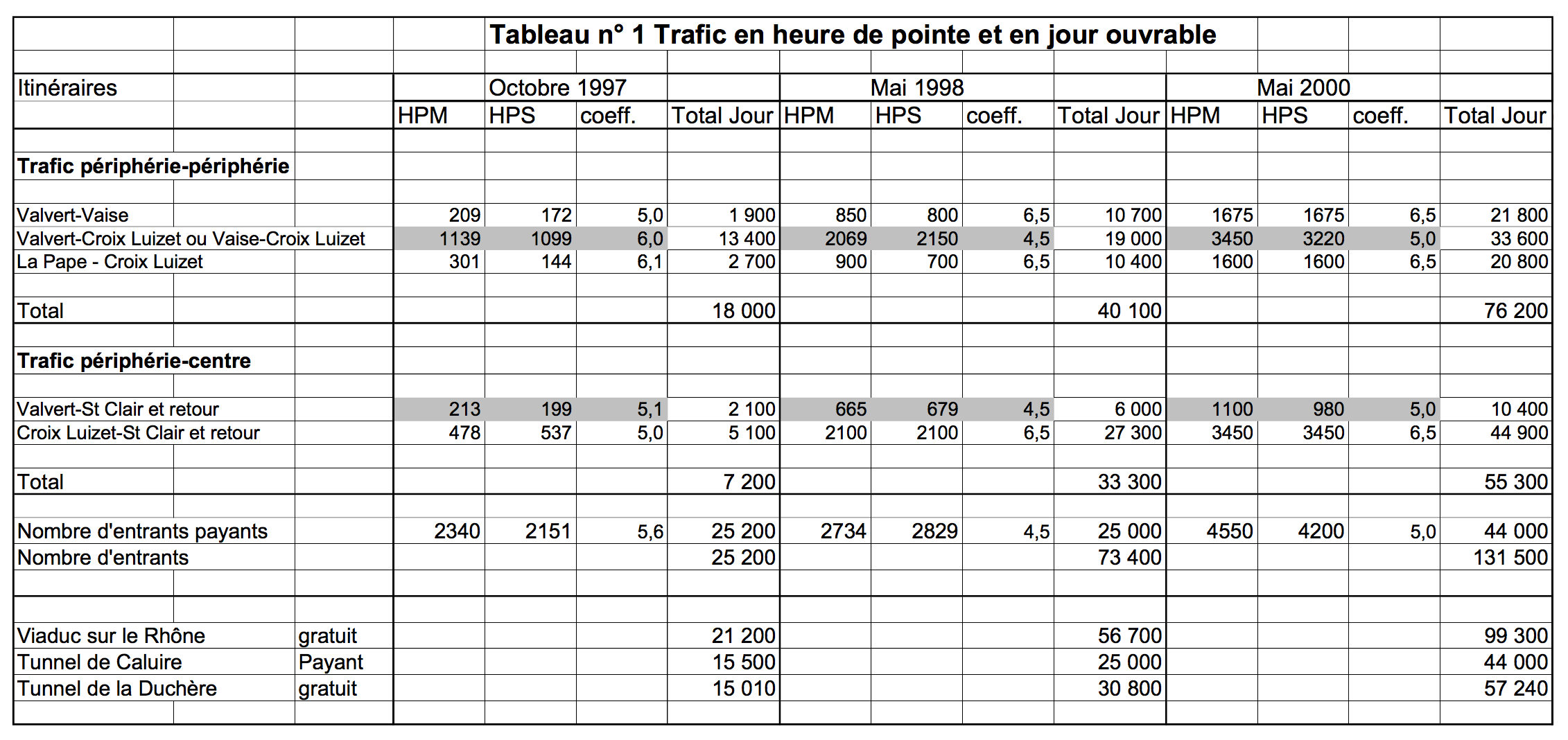
The route chosen for this new piece of infrastructure was thus relatively straightforward; only the technical solutions for the river crossings needed to be worked out. Given the bypass road’s potential for traveling through the urban area rapidly, the route had to be capable of attracting a large number of motorists. It was thereby decided to apply a toll to this facility. However, a high toll served to dissuade motorists from using the road in the first place, thereby making its very existence virtually unnecessary since vehicles wound up crossing the city center in any event. A lower toll, according to traffic simulation models available at the time the toll was decided, would have caused revenues to plummet, thereby representing a greater tax burden.
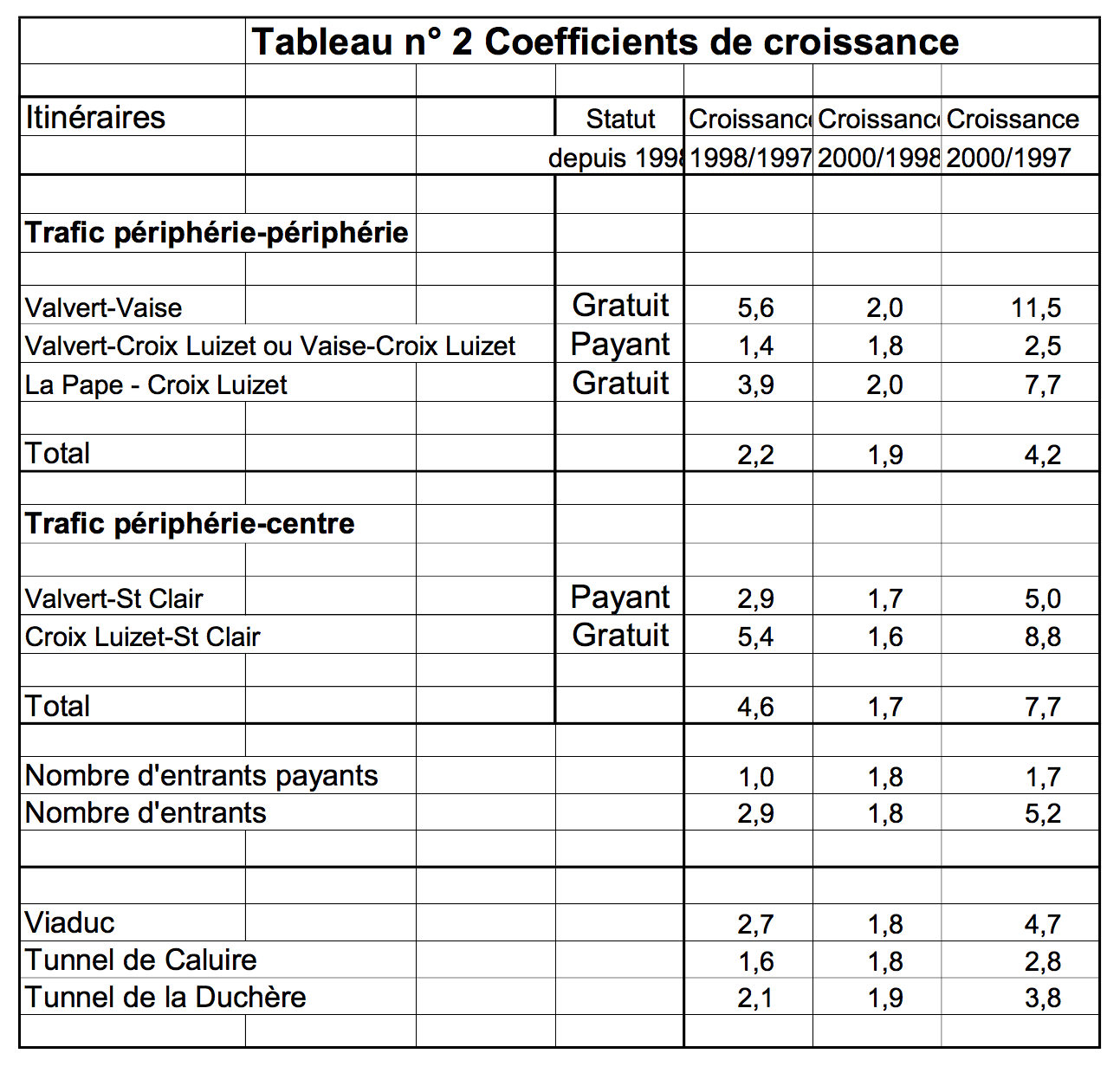
This equilibrium between tax burden and toll revenues was the key to the discussions held. In the September 1998 article (Transports, n° 385), we exposed the error with the initial toll schedule which, by virtue of being too expensive, meant that the facility was not fulfilling its function and the municipality was struggling to cope with the underlying political ramifications due to a lack of standardized methodology. Furthermore, the private concession was annulled for yet other reasons; the municipality wound up assuming responsibility for the entire operation, buying out the concessionaire and applying a much lower rate schedule that was more compatible with the level of service being sought by both local planners and motorists.
Tables 1 and 2 above display the evolution of traffic for the major origin/destination pairs. Those trips allowing a sizable time saving for motorists, able to cross a natural obstacle more easily (i.e. the Caluire tunnel), only exhibited a small rate of increase, which signifies that the advantage offered by the facility was recognized from the outset. Stronger increases between 1997 and 1998 were experienced with respect to only the most essential trips.
1.3.2 The Canadian example (the A 407 Highway): Video recorder vs. a transmitter/receiver device
During the same period in Canada, a call for tender was being held for the sale of an urban toll road: Highway A 407, the city of Toronto’s northern bypass. This project consisted of a 70-km stretch of highway with a toll structure that differentiated between two types of customers: frequent users, who were equipped with a transmitter/receiver and benefited from a relatively inexpensive toll (1.00 to 1.50 Canadian dollars, or 4 to 6 francs, per trip depending on the distance traveled); and infrequent users, who had not purchased regular passes yet could be identified via a video recording of their license plates both upon entering the facility and at the exit (with the toll charged ranging between 2 and 3 Canadian dollars per trip).
This highway has been built with many regularly-spaced exits, a feature which allows drawing up a highway- user profile by mode of payment. The “distance” scale of the graph does not represent the number of kilometers traveled, but rather the succession of exits. The users equipped with transmitters/receivers make shorter trips, with frequency levels increasing for smaller distances. Users concerned by the video recording system, on the other hand, reveal a perfectly constant trip length distribution over the entire highway segment. For longer distances, regardless of the mode of payment, the number of users remains the same, suggesting that the exceptional nature of the trip (in conjunction with its significant length) had reduced the motorist’s sensitivity to the toll amount.
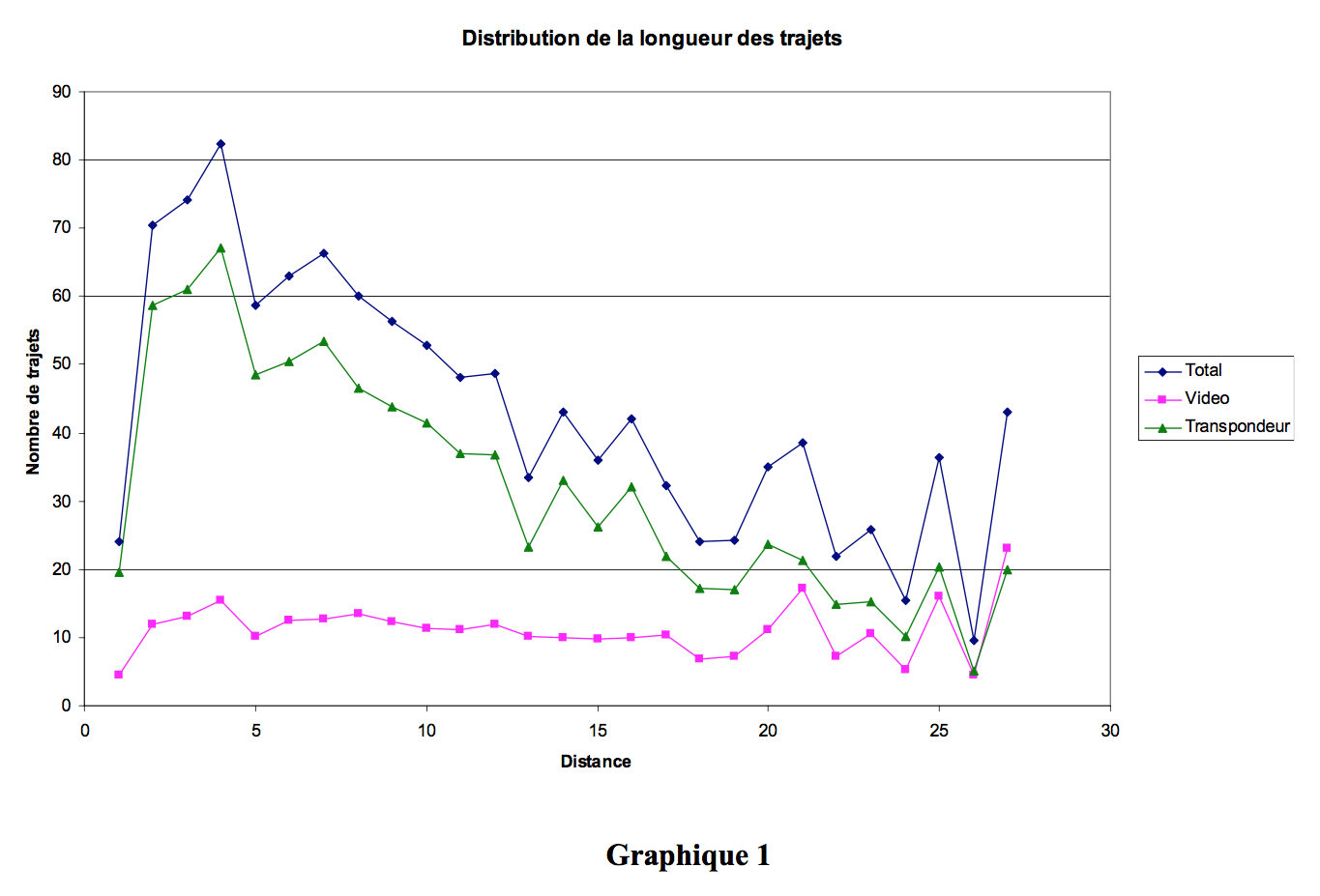
2 Underlying behavioral laws
The handful of observations discussed above, along with other analyses carried out both in Argentina on the Buenos Aires urban tolls and in Brazil on Rio de Janeiro, have led us to confirm the hypotheses forwarded two years ago on the political acceptability of tolls. These hypotheses can be boiled down to three key points:
The willingness to pay is dependent upon trip length.
As a route’s degree of mandatory use increases, its toll is drawn down.
As the frequency of facility use increases, the toll is drawn down.
In what follows, we will address these specific points.
2.1The degree of mandatory use
We will not repeat the contents of our 1998 article on the political acceptability of tolls, but simply add a few insights.
It is obvious that the cost of an industrial good drops when entering into mass production, by virtue of longer production runs and sizable scale effects. The converse is equally as obvious: a lower-cost industrial good reaches a broader market and hence enters into mass production. The most striking examples in Europe over the recent past are the cellular phone and the microcomputer.
Average number of trips
In the case of road tolls, an analogous phenomenon is at play: the increasingly widespread use of the automobile has reached the less “well-to-do” population segments, notably in terms of commute patterns. Consequently, even if the toll facility has not undergone any renovation work, its customer profile has and the toll structure must reflect this fact. The most accurate measure of a toll facility’s use level, for a given travel corridor, is the ratio of toll facility use to total corridor traffic (toll facility patronage + traffic on the toll-free network). This ratio is known as the facility’s “catchment rate”. As the toll rises, the catchment rate drops.
This supposition however implies that users have been given the choice between two similar services, in terms of both time and cost. If such were not the case, the toll facility would be in a quasi-monopolistic situation, and the underlying reasoning would be different: the rate schedule for a public service facility could not be structured as inaccessible to a majority of the population. Herein lies the principal difference between a piece of infrastructure and an ordinary consumer or household good. As an analogy, let’s take the example of restaurants/food services. The market offers high-quality and expensive restaurants; still no one is obliged to dine in one of these establishments. The presence of such restaurants has not reduced the number of lower-priced restaurants, just as the production of luxury cars is not detrimental to the market for economy models.
The same argument holds as regards infrastructure, inasmuch as supply conditions are much more restrictive. The sum of capacities on both toll and non-toll facilities within a given travel corridor must naturally correspond to the total demand. Yet the capacity of the toll facility remains high with respect to non-toll facilities (or rather to total corridor capacity, all modes of transportation combined); moreover, the toll facility always requests some type of public subsidization, which would make inaccessibility for a segment of the population an unacceptable proposition and incite taxpayer “discontent”.
2.2 Frequency
When the “frequency” effect is added to the “degree of mandatory use”, as discussed in our 1998 article, the political sensitivity to the toll rate gets magnified: reasoning then runs along the lines of a monthly toll budget, placed in comparison with the total household budget. The response in terms of rate-setting turns to creating a range of user pass formulae adapted to each specific use category.
2.3The willingness to pay as a function of time saving increases with trip length
Although this effect is rarely incorporated into model set-ups, the willingness to pay is not a fixed parameter, but rather depends on the time saving actually achieved. Such a statement should not come as a breakthrough when perusing the literature over the past six years on the subject. A pertinent and in-depth HCG study has confirmed the findings of studies conducted at France’s INRETS institute by O. Morellet (based on the MATISSE model). For purposes of verification, we have been given the opportunity to reprocess a good amount of data from declared preference surveys performed in a number of countries by the HFA consulting group: the correlations derived with a variation in the willingness to pay as a function of distance were markedly better than those with the conventional method.
The Lyon and Toronto case studies help reinforce these observations. We are now convinced that the application of traffic models not taking account of this basic behavioral law would yield completely erroneous results. This remark is of critical importance for future urban development projects as well as for urban toll policy initiatives. The natural rate-assignment curve for a given trip should be parabolic in shape and not linear, at least over the initial trip segment.
3 Written contracts and tacit contracts
Whether the toll pertains to a facility or an urban zone, whether the concessionaire is a public or private entity, the legal and financial framework remains the same. All of the interrelationships between actors are formalized by means of contracts, rules, laws, shareholder agreements, performance bonds, etc. The legal apparatus is in place for shaping the written expression of actors’ intention at the time of contract signature as well as for outlining what will result from such and such circumstance.
3.1The actors
Let’s consider the case of a concession which ties a local public authority (a municipality, department or region) to a concessionary company. The seven distinct actors involved are listed below :
the concessionary company itself, represented by its shareholders, whose aim is to realize dividends once
the financial climate allows to do so (arrow no. 7 in the diagram) ;
the end user, who pays for the proposed service. This actor is represented by the motorist or the
transportation operator, which pays a fee for use of the infrastructure made available (arrow no. 1);
the concession-granting authority. This actor holds the power to: determine the level of service to be provided, grant a facility concession to meet the level of service so defined, put a concession out to bid, issue guarantees or award subsidies, and sign the concession contract with the designated concessionaire
(arrow no. 2) ;
the Ministry of Finance, which collects the direct and indirect taxes on both the contract and the income
stream generated (arrow no. 3) ;
the lending organizations, which advance the funding necessary to build the facility and then begin to be
reimbursed only once it is operational (arrow no. 4) ;
the construction firm, which is responsible for building the project on behalf of the concessionaire (arrow
no. 5) ;
the facility operator, which collects tolls and performs all necessary maintenance work on behalf of the
concessionaire (arrow no. 6).
In many instances, the same organization fills the roles of several actors. For example, a situation may arise where some of the concessionaire’s shareholders are construction firms and/or service operators. As such, they will not have the same strategic outlook on the project as shareholders with a purely financial interest, since the former are involved at several stages in the project and accumulate different types of risks and returns. It is also quite frequent for the public authority to act either as the concession-granting authority, sole shareholder in the concessionary company, tax collector, or even lender! It goes without saying that the psychological reactions of motorists with respect to the toll rate will not be the same whether the authority is public or private.
The arrows indicate the direction of monetary flows in the case of a conventional concession, with Diagram 1 representing the construction period and Diagram 2 the operations period.
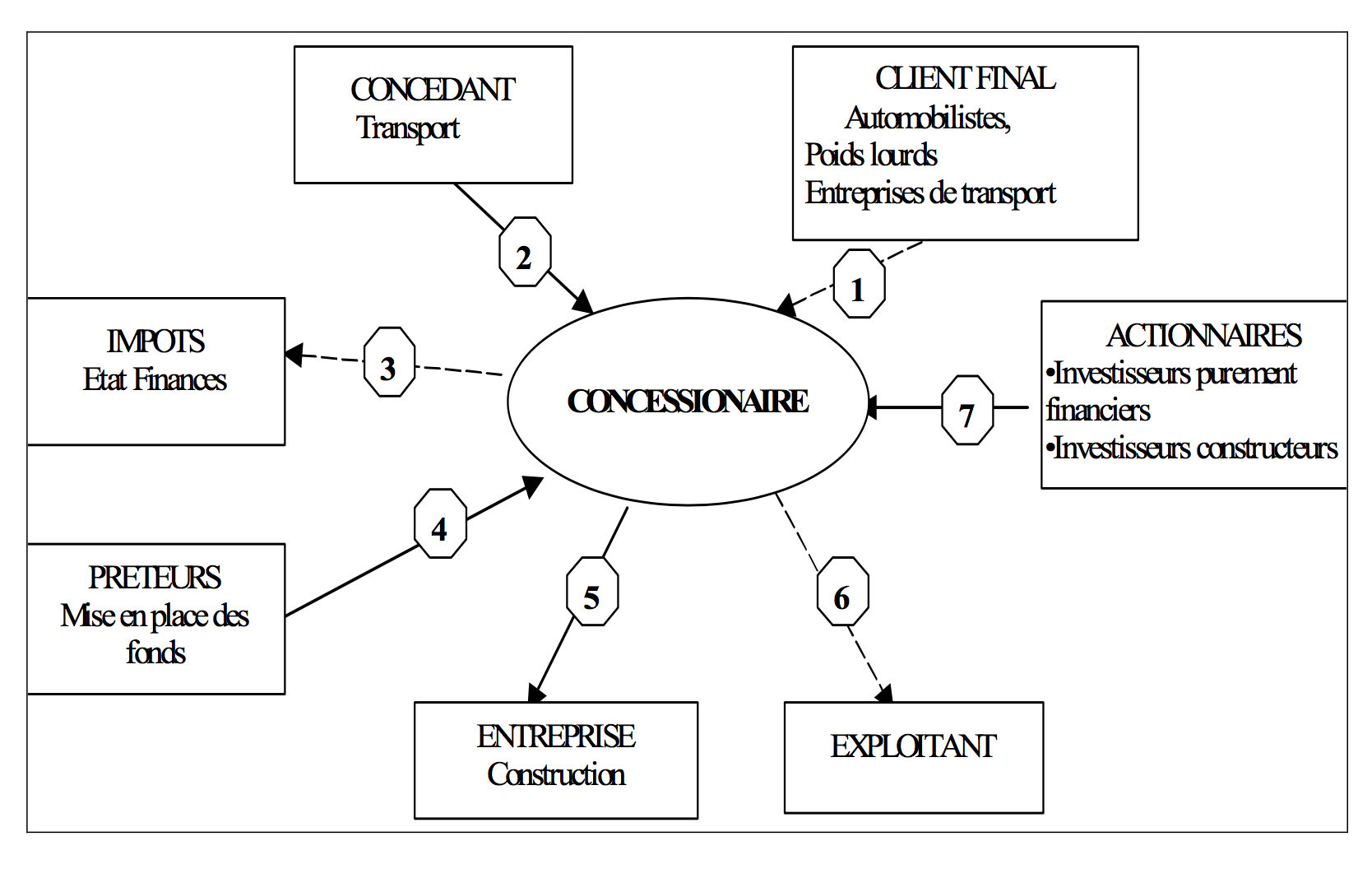
Diagram 1: Legal relationships among actors participating in a conventional concession
3.2Tacit contracts
We have observed that a purely-financial approach does not suffice in describing the reality of a concessionary contract’s life cycle. The political dimension, which is manifested by the toll schedule and a measure of user “discontent”, reflects the fact that two types of tacit (unwritten, difficult to formalize and not well-known) contracts actually exist, tying:
the population to the concession-granting authority; and
the group of facility users to the population as a whole.
Prior to granting the concession and initiating the bidding procedure, the political decision to build a facility and divide the ensuing costs between taxpayers and users has already taken place. These two categories of population are far from being one and the same. All State (or local) residents pay taxes and express their opinions at the ballot box. The customer, on the other hand, is an individual who determines the acceptability of paying a given amount at a given time for the service being proposed by the concessionaire. Only a portion of the population is composed of actual customers, yet the other portion still benefits indirectly from the presence of the new facility (less congestion on the road network constitutes a benefit for all residents, whether motorists or not) without having to pay any toll.
Two types of tacit contracts thus serve to bind the concession-granting authority to the population when it comes to setting tolls at a level that optimizes use of the facility, i.e. whereby each population segment considers the price to be right given the benefits, either indirectly (through taxes), directly (toll) or in a mixed form (a toll facility subsidized up to 50%, 70% or even more by tax revenues).
The following diagram depicts the various actors in the concession by indicating explicitly both political ties and the social acceptability of toll levels between the population, the concession-granting authority and the customer.
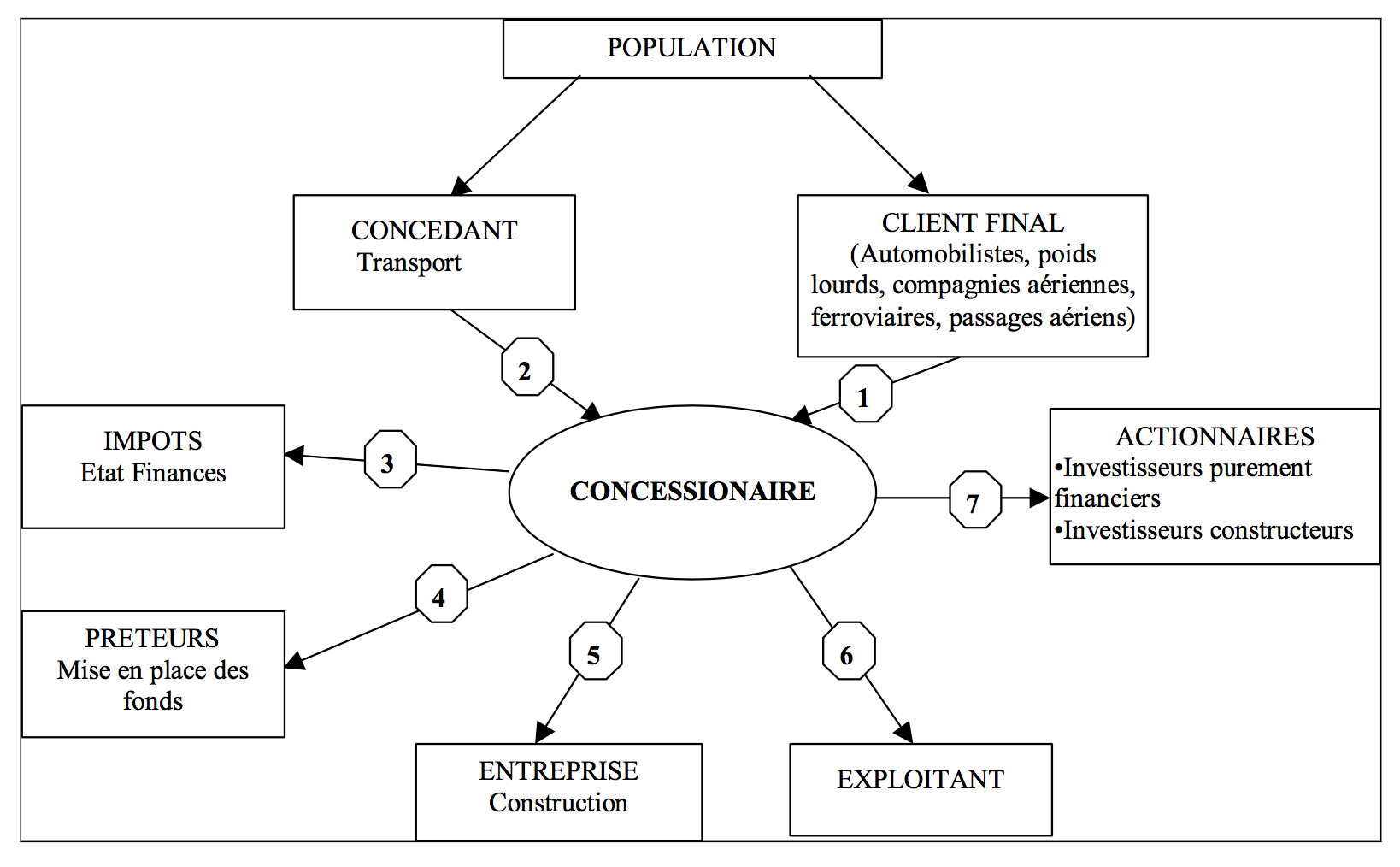
Diagram 2: Tacit contracts
4 An attempt at a quantitative approach based on the Marseille experience
4.1The exaggerated sensitivity of traffic models to the set of initial hypotheses suggests seeking an overall urban rationale.
The following graph highlights the extreme sensitivity of simulation software to the set of input hypotheses. For urban traffic speeds varying from 12 km/hr to 30 km/hr (depending on the level of congestion in the particular zone) and for a willingness to pay varying between 30 and 180 francs an hour, the toll rates derived theoretically range from 0.60 to 12.50 francs per km, hence a 1-to-20 ratio of potential divergence.
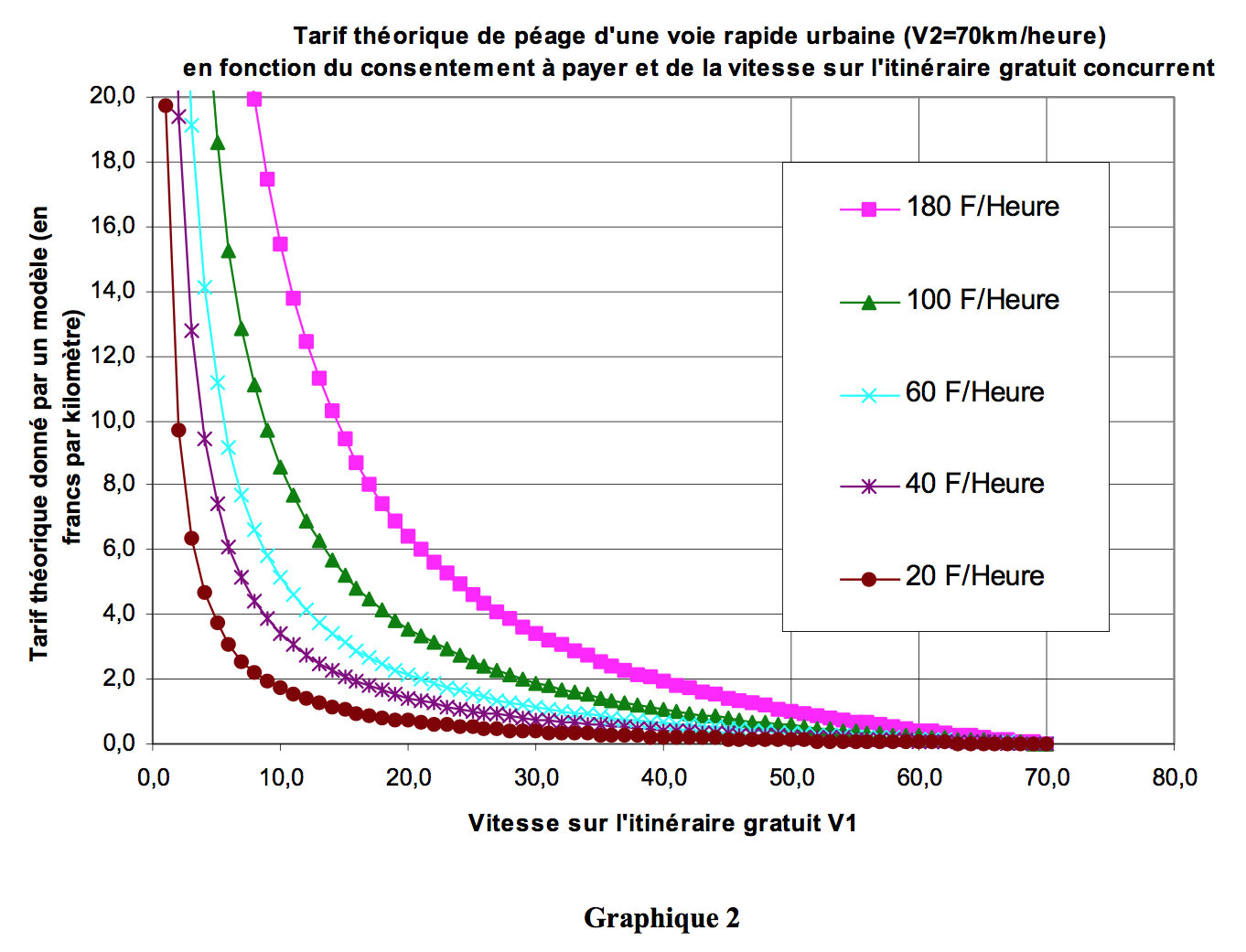
Instead of perfecting a model and refining its description of reality, we have adopted a global approach, one aimed at coalescing as much as possible the “transportation” phenomenon with the “planning” phenomenon; in doing so, we have relied upon an extremely simple description of reality. The result is more of a picture than an actual model, yet the mechanisms involved are indeed the same as those driving the current all-purpose models.
4.2Usable data being generated in Marseille, Lyon, Lisbon and Toronto
The reprocessing of existing data on toll facilities currently in use with a revised analytical method has yielded some most revealing conclusions.
We began by assuming a normal log distribution of the willingness to pay parameter. This distribution had been successfully tested in the “Péage 2” studies conducted on Marseille data from 1996 and 1997. We did nonetheless modify a key parameter: the standard deviation was set at 0.5, as opposed to 0.7. Here’s why: with the law on the willingness to pay increasing as a function of distance, the distribution with a 0.7 standard deviation yields a constant revenue for a toll rate varying between 15 and 40 francs. This finding seemed to us unrepresentative of the situation in Marseille; we therefore reduced the number of “well-to-do” or “hurried, less
Theoretical rate given by a model (in francs per kilometer)
well-to-do” motorists by decreasing the standard deviation. In spite of this adjustment, tests run with a standard deviation of 0.7 still produced similar results.
We did take account of variations in the willingness to pay as a function of trip length. For those trips with a time saving of less than 12 minutes, the time saved was cut back; conversely, for trips of over 12 minutes, this figure was gradually increased in order to reach a saving ratio of 1.5 for a 30-minute trip and 2.0 for a 11⁄2-hour trip. The corresponding multiplicative law is of the following form: y = 2*(1-exp(-k*dt)).
We have depicted two routes for traveling from point A to point B, located 12 kilometers apart: one without toll, and the other using a toll facility. Both routes are exactly the same distance and only differ by the payment of a toll on one of them. The data and results pertaining to the two routes have been denoted by the indices 1 (free) and 2 (toll), respectively. To carry out the “with vs. without project” comparisons, we have introduced a reference situation, denoted by the index 0.
Operating costs on both routes are identical and no bonus or penalty has been ascribed to either one. In order to set the framework, a calculation was conducted on the basis of a demand of 2,000 vehicles in each direction, which in fact corresponds to two lanes of tunnel traffic during rush hour. The rule used for assigning vehicles to one route or the other was an “all-or-nothing” law, whereby the vehicle chooses the route offering the lower combined cost (i.e. value of time + toll).
We employed a flow-speed law for the free route and another for the toll route. These laws both exhibit hyperbolic shapes which have been calibrated with realistic conditions. Other laws may obviously be suitable, however the “free-flow speed” and “saturation speed” limits must not be modified given that they correspond to real-life observations. The toll-free route, presented as being unique, is in reality the sum of parallel or similarly- oriented toll-free routes, the cumulative capacity of which has been used in the present model.
For the travel time corresponding with the “without project” situation, we relied upon the knowledge acquired of the urban layout and traffic patterns within the cities studied; it turns out to be fruitless to apply a “without project” speed law. Only the A-to-B travel time is of interest to us herein and this data element is available in either the traffic studies or local planning studies.
The model is intended to identify the equilibrium between traffic flows on the toll-free route and the toll route, at a given toll level. Once this equilibrium has been reached, the model calculates: the economic surplus of motorists on the toll-free route (surplus 1); the economic surplus of motorists on the toll route (surplus 2); the amount of toll revenue generated; total user surplus (defined as the sum of surplus 1 and surplus 2); and the public authority surplus (defined as the sum of total user surplus and toll revenue).
The calculation method used does not accommodate any induced traffic, which in urban areas proves to be sizable. This induced traffic may be considered as a good (see the latest transportation survey, which indicates a rise in trip-making rates). However, this positive impact must be placed into perspective by including environmental and area-wide economic aspects as well: a rational urban layout leads to smooth overall operations with a limited number of trips at high speed. A forced trip generates negative surplus. In short, the determination of a facility’s appropriate scale should be left up to the forces of urban planning and not to those of transportation economics.
4.3The introduction of a quantifiable parameter to reflect the presence of tacit contracts
Two key problems still had to be resolved: how to quantify the “discontent” experienced by taxpayers unable to use the toll facility, and which acceptability criterion should be ascribed? To help shape our response, we were able to glean insight from the experience of the Prado-Carénage Tunnel operating company in Marseille, thanks both to the existence of an accessible and thorough database and to the personal interest conveyed by the company’s President Claude Abraham in these topics. It was in fact Mr. Abraham who came up with the rule, which carries his name, for assigning traffic between competing routes on the basis of the cost ratio to the 10th power. His ideas and experience have had a tremendous impact on refining the model used in the present article. Our own experience in Lyon, Lisbon, Buenos Aires, Rio de Janeiro, Toronto and Paris has served to validate the mechanisms behind this reasoning.
This new notion of “discontent” is purely psychological and not at all economic in nature. It measures the fact that motorists are not sufficiently willing to pay to use the toll facility, but would gladly use it at no charge. This intrinsic “discontent” is defined as a negative surplus, equal to the product of the time difference T1-T2 multiplied by the difference between the willingness to pay of the population segment “disenfranchised” from the facility and the willingness necessary for the toll’s acceptance. This means that a “less well-to-do” disenfranchised motorist experiences greater discontent than a “more well-to-do” motorist. This also suggests that a motorist “on the verge” of paying the toll is only slightly discontented. The entire issue therefore lies in the political realm and equity considerations as opposed to the economic realm.
Surplus 1 of those disenfranchised from the toll facility is thereby reduced by “discontent” and the resultant behavioral effects, called the “net surplus”, can then be assessed. This approach entails combining an economic quantity with a psychological quantity. While the method may not be flawless, the outcome is most incisive.
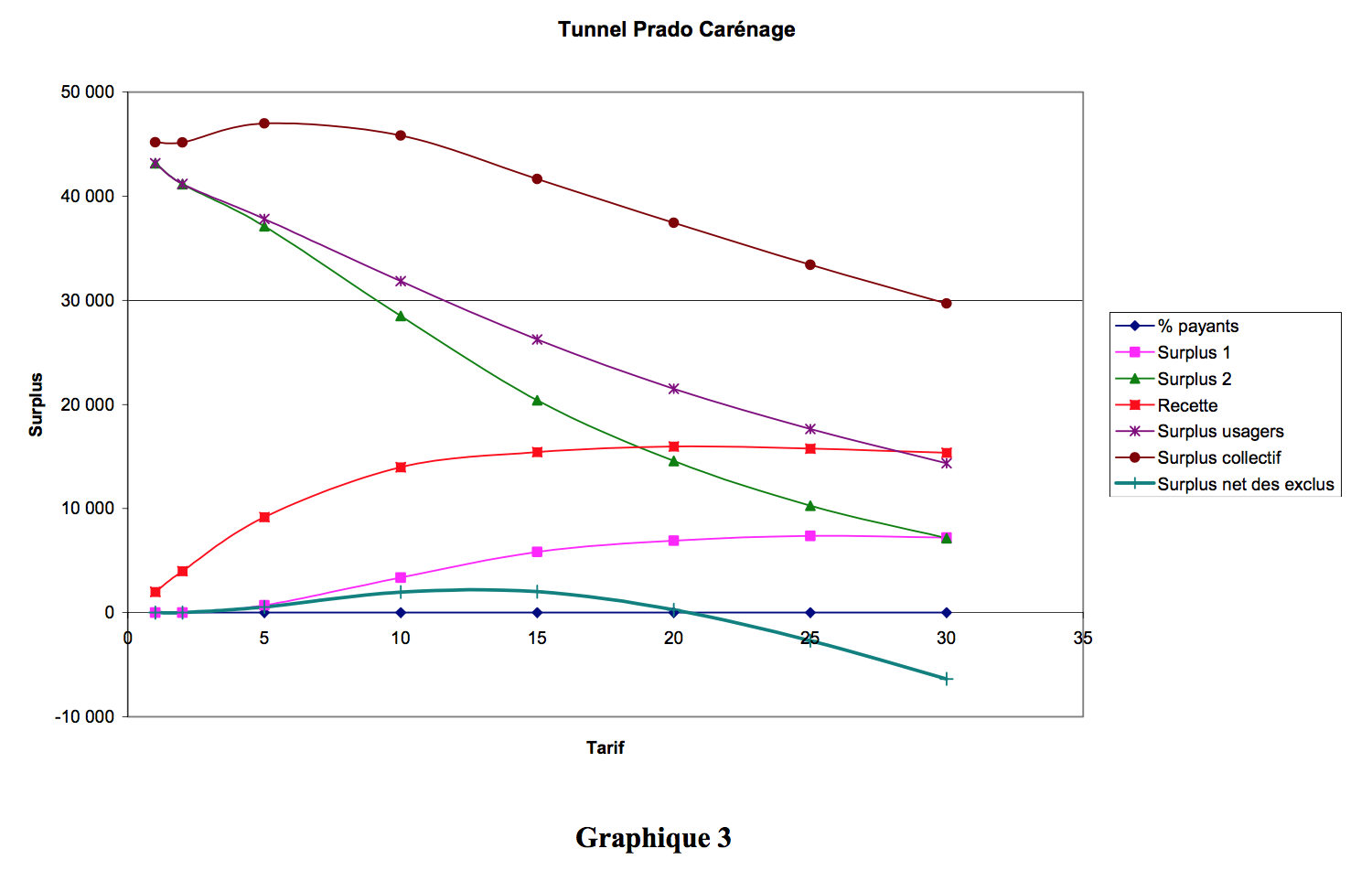
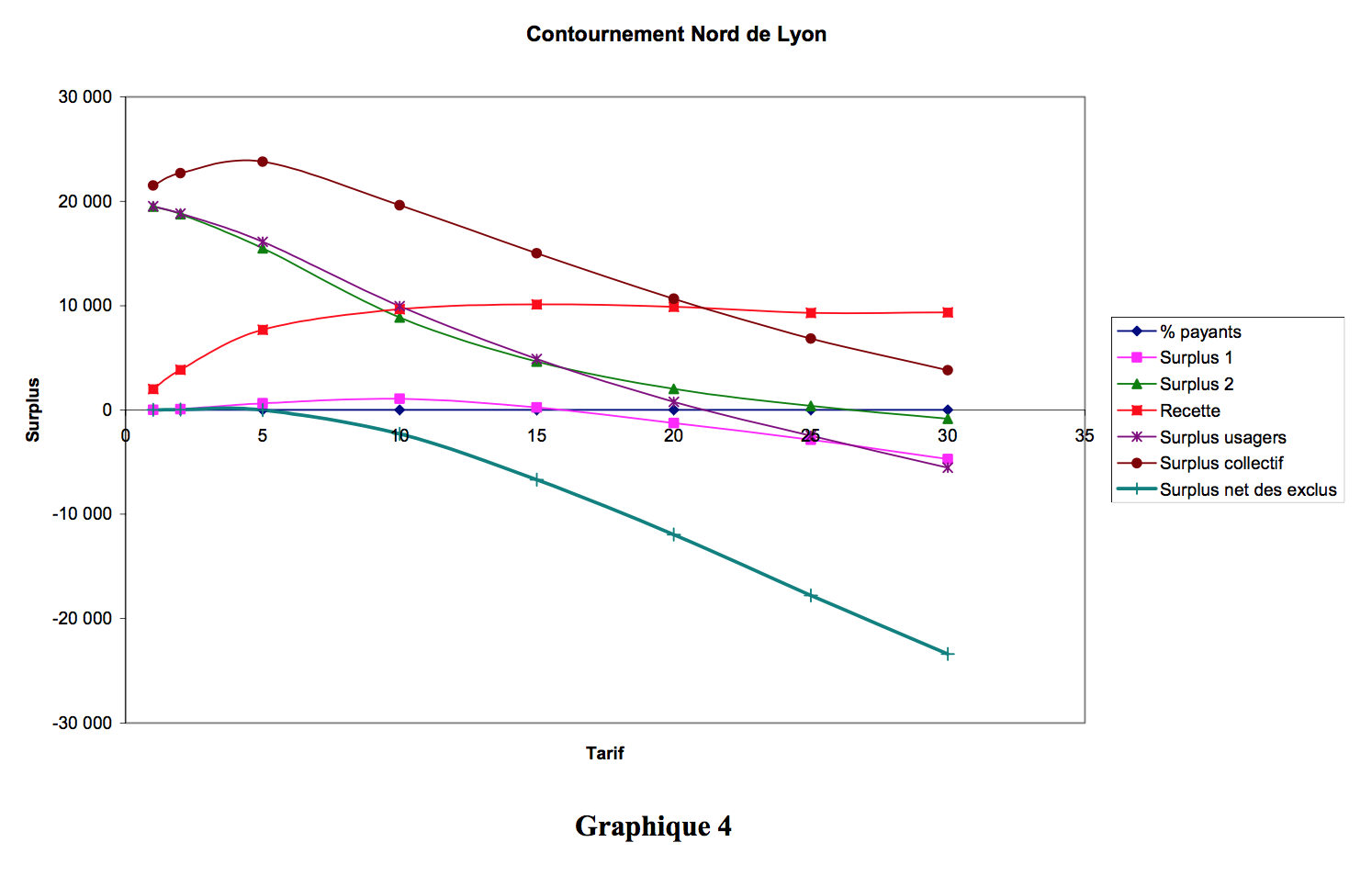
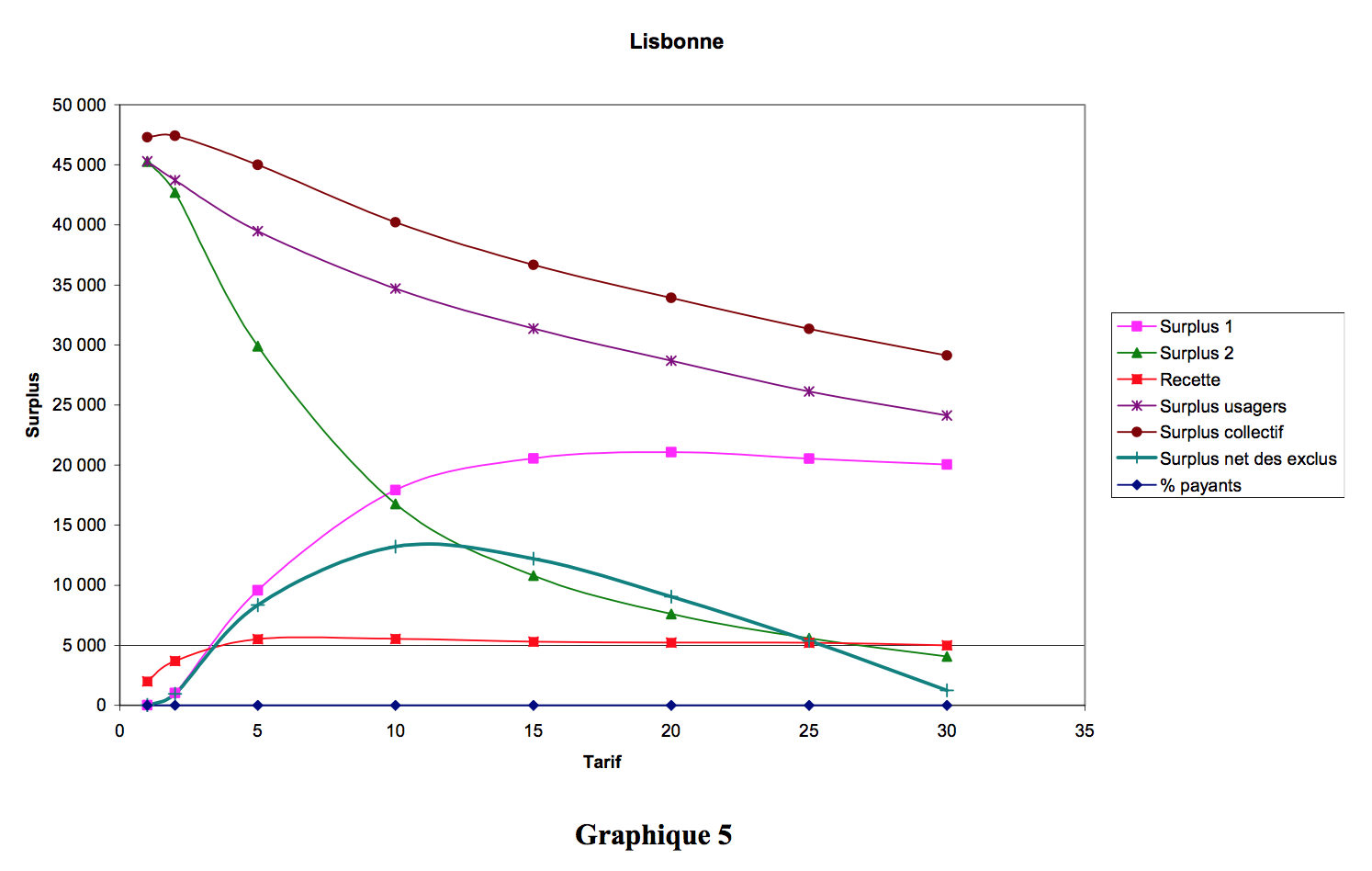
Graphs 3, 4 and 5 below illustrate the examples of the Prado-Carénage Tunnel, the Northern Lyon bypass road and the Tagus River Bridge in Lisbon, respectively.
Toll rate
The percentage of motorists using the toll facility has been indicated on the graphs’ right-hand scale. The net surplus (net of the disenfranchised) is shown in bold.
It can be observed that in Marseille, the net surplus is maximum at a toll level of between 10 and 15 francs, whereas the concessionaire maximizes revenue at a toll between 20 and 25 francs; the authority’s maximum lies around the 5-franc mark. This maximum (approx. 50,000 francs) is much higher than the amount of toll revenues (on the order of 15,000 francs). On an annual basis, revenues reach 150 million francs (MF); the tunnel, currently priced at 14 francs, generates a collective surplus in the range of 500 MF a year.
For the Northern Lyon bypass road, the situation is altogether different: the surplus from the disenfranchised always remains negative, except at a toll rate of practically zero. This assertion reflects the fact that the travel speed of the disenfranchised goes lower after facility start-up than before. If this result is in conformance with the particular urban project, the population will demand explanations and specific precautions will have to be taken during the implementation phase. For a revenue level of 10,000 francs, the collective surplus is only 25,000 francs, which would require a toll of between 5 and 10 francs. The urban renewal efforts both in the Vaise District and along the banks of the Rhone River provide the complementary value enhancement for justifying the project.
In Lisbon, the net surplus is positive as long as the toll remains less than 25 francs. Its maximum is situated at a level of 10 francs, while a 25-franc toll would deplete this surplus. Toll revenues plateau as of the 5-franc mark. Yet, our view of this traffic situation is too simplistic in the case of Tagus River bridges, inasmuch as the older bridge had been displaying the behavior of a quasi-mandatory toll (i.e. a tax), whereas the new bridge represents an additional service. The perception of toll represents in fact the difference between the rates charged on the two bridges, with the distance separation inducing a bias: in order to derive an accurate result, the same method must be utilized yet with the model calibrated to actual traffic levels.
4.4What are the lessons to be drawn?
The surplus for the local authority depends to a great extent on the “without project” speed, known as the “reference” speed. Herein lies the critical feature with respect to socioeconomic profitability calculations for urban projects. As pointed out by O. Morellet in his Marseille study using the MATISSE software, it is simply necessary to extend the total travel time by 1 minute (e.g. one more red light) in order to produce a 5% shift in tunnel traffic. (This order of magnitude had already been cited in a previous article.) A 5% swing in traffic levels
Surplus
corresponds to 7.5 MF in annual revenue, hence the possibility to absorb 100 MF of additional financing! A couple of observations are called for in helping avoid order-of-magnitude errors:
It is not fatal for an urban area to be saddled with a poor transportation network: adjustments on the demand side (e.g. trip scheduling, destinations, number of trips, mode of transportation) act to modify the network’s layout and operations. Consequently, some areas of the city may be devalued, yet the average speed will remain above a certain threshold.
In the case of physical obstacles (e.g. bridges, topographical relief), building a road is tantamount to proposing a new service, which entails much more than time saving and ultimately exerts a heavy impact on traffic patterns as well as on real estate values of the urban zones being served. The level of added “urban value” is thus considerable. Nonetheless, any economic assessment should take into account the fact that had new activities not located in these newly-connected urban zones, they would have done so elsewhere. The appropriate measuring stick therefore should be the differential benefit between two competing urban development scenarios.
The choice of which average reference speed to use in economic calculations proves to be of vital importance. In more traditional European cities, this speed rarely drops below 20 km/hr, in comparison with frequently- encountered streetcar operating speeds of 18 to 19 km/hr.
In Lisbon however, the extreme level of congestion on the older bridge had brought this speed down to about 12 km/hr for Tagus River-crossing trips, a figure which justifies the considerable economic benefit derived from the construction of the Vasco de Gama Bridge.
5 Conclusion
To choose or not to choose, that is the question. If a choice of routes exists, the classical Jules Dupuit-inspired surplus calculation is to be applied. Rationality dictates that the concession-granting authority should set a toll and rating practices in accordance with political imperatives and then leave the commercial strategy up to the concessionaire. Otherwise, the toll would fall in the category of a tax.
5.1When the degree of mandatory use is high, the toll is considered as a tax and hence must be designed accordingly.
In establishing the equilibrium between tax-based and toll-based financial resources, the most critical parameter in our view is the degree of mandatory use. The toll charged on a facility with a high degree of mandatory use is, in essence, a tax. The same would apply to a zone-wide toll. Such a toll must not be expensive and must not exclude a significant segment of the potential demand. In the event of an overpriced toll, the speed law V1 would turn out to be much lower than V2, thereby leading to considerable “discontent” of the disenfranchised and highly-negative political reactions. Low toll levels, which can be qualified as “painless” from the standpoint of not significantly disrupting user behavior, prove to be the most logical and easily accepted.
If the toll rates applied modify behavior despite a high degree of mandatory use, beware of ensuing political problems!
5.2The maximization of toll revenue is tantamount to a strong level of discontent.
It is obvious that the revenue-maximizing toll rate is going to be rather high: this rate represents the one normally sought by any conscientious concessionaire. Yet at this toll level, user discontent also reaches major proportions. It is incumbent upon the concession-granting authority to determine what level of discontent can be withstood politically. On this basis, the authority will set up, in conjunction with the concessionaire, the corresponding written contract. The difference between optimal revenue and the revenue level corresponding to the toll schedule adopted by the authority (i.e. the concessionaire’s opportunity loss) is then to be granted as
compensation. In Lisbon, this compensation takes on the triple form of a direct subsidy, a “shadow toll”-type complement, and a lower VAT rate. These are just a few among a wide array of possible forms of compensation.
5.3The revenue curve remains relatively flat: Use it most judiciously.
According to what can be construed about existing concessions, it would seem that the revenue curve as a function of toll rate remains rather flat. No practical experiments have ever been attempted; the Washington- Dulles example does attest to the difficulties involved. In recognition of this point, the appropriate toll rate would correspond to a sub-optimal revenue profile, somewhere between the maximum collective surplus and the maximum net surplus (net of the disenfranchised segments).
5.4The zone-wide toll involves an analogous approach.
The notion of disenfranchised is quite straightforward to define in the case of a toll facility, yet proves less so in that of a zone-wide toll. When local authorities instituted a toll zone in Oslo and Singapore, they laid it out so that: toll rates would remain low, shorter trips would be limited, and the least well-off would not be adversely affected.
Depending on the toll level, the rate charged may or may not modify motorist behavior (trip-making patterns). If it does not, the toll reverts to being a simple tax and perhaps not even as effective as a well-designed parking policy. If it does, the urban issue at stake is broader than transportation alone, given the transformations taking place within city districts. This topic has begun to be examined by the City of London, in its project to create a “toll ring”, and the Mayor fully realizes that his political career is on the line here.
To go beyond this basic observation and enter the realm of judicious long-term decisions for the city, the introduction of planning-related quantitative parameters is essential. Defining the notion of choice is indeed critical: simply selecting which route to take entails de facto a lifestyle choice. This immense topic still requires imagination and more work, much more work!
